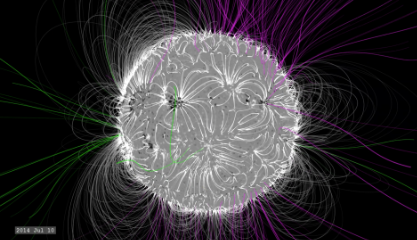The Sun is nearing its solar maximum, a peak in its 11-year activity cycle, marked by heightened magnetic disturbances and increased solar events like flares and coronal mass ejections (CMEs). This period is significant as it can impact Earth’s space weather, affecting satellites, GPS, radio communications, and even power grids.
What’s Happening on the Sun?
Scientists have long studied the Sun’s magnetic field, but its exact origins remain unclear. “We’re not sure exactly where in the sun the magnetic field is created,” said Dean Pesnell, a space scientist at NASA’s Goddard Space Flight Center. The Sun’s plasma—a state of matter consisting of charged particles—generates these fields through a process known as the solar dynamo.
At solar minimum, the Sun’s magnetic field is relatively weak and concentrated at the poles. But as it moves toward solar maximum, the magnetic field becomes more tangled and complex, creating active regions that trigger solar events.
How Do We Observe the Sun’s Magnetic Fields?
Since magnetic fields are invisible, scientists rely on indirect observations:
- Extreme ultraviolet (EUV) imaging captures plasma loops and structures in the Sun’s outer atmosphere, the corona.
- Magnetographs measure the strength and direction of the magnetic fields on the Sun’s surface.
- Computer models like PFSS (Potential Field Source Surface) help map how these fields behave over time.
Comparisons from previous cycles show how the Sun’s magnetic field evolved from solar minimum (2011) to solar maximum (2014). During this transition, the once-smooth magnetic field became more disordered, leading to frequent and intense solar activity.
Potential Impact on Earth’s Technology
As the Sun reaches peak activity, solar flares and CMEs become more common, increasing the risk of:
- Satellite Disruptions – High-energy particles from the Sun can damage electronics on satellites, leading to signal loss or degraded performance.
- Communication Failures – Radio signals, particularly HF (high-frequency) communications used in aviation and military operations, can be disrupted.
- GPS Inaccuracies – Solar storms can interfere with satellite-based navigation systems, causing errors in location tracking.
- Power Grid Disturbances – Strong geomagnetic storms can induce currents in power lines, potentially causing transformer failures and blackouts.
Monitoring the Solar Maximum
Space agencies, including NASA and NOAA, continuously monitor the Sun’s activity to provide early warnings of potential solar storms. Improved models and satellite observations help forecast space weather events, allowing operators to take preventive measures to protect critical infrastructure.
As solar maximum progresses, scientists will closely study its effects to refine future predictions and develop better mitigation strategies. The coming months will be crucial in understanding the Sun’s impact on Earth and space-based technologies.
Stay updated as researchers track the Sun’s behavior during this peak phase of its cycle.













